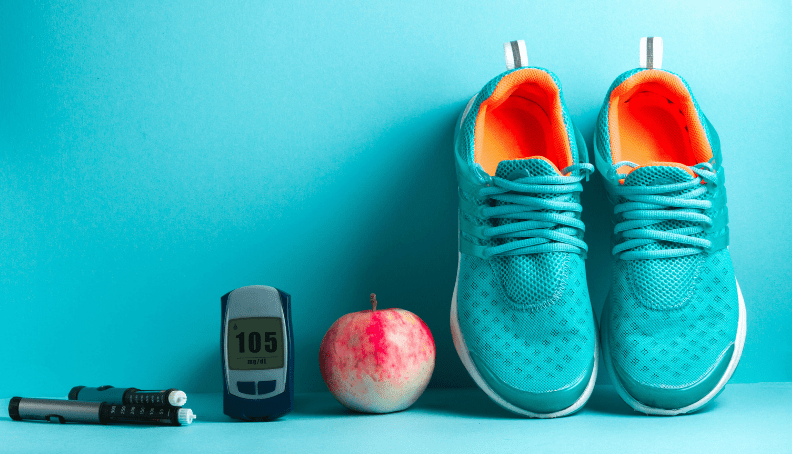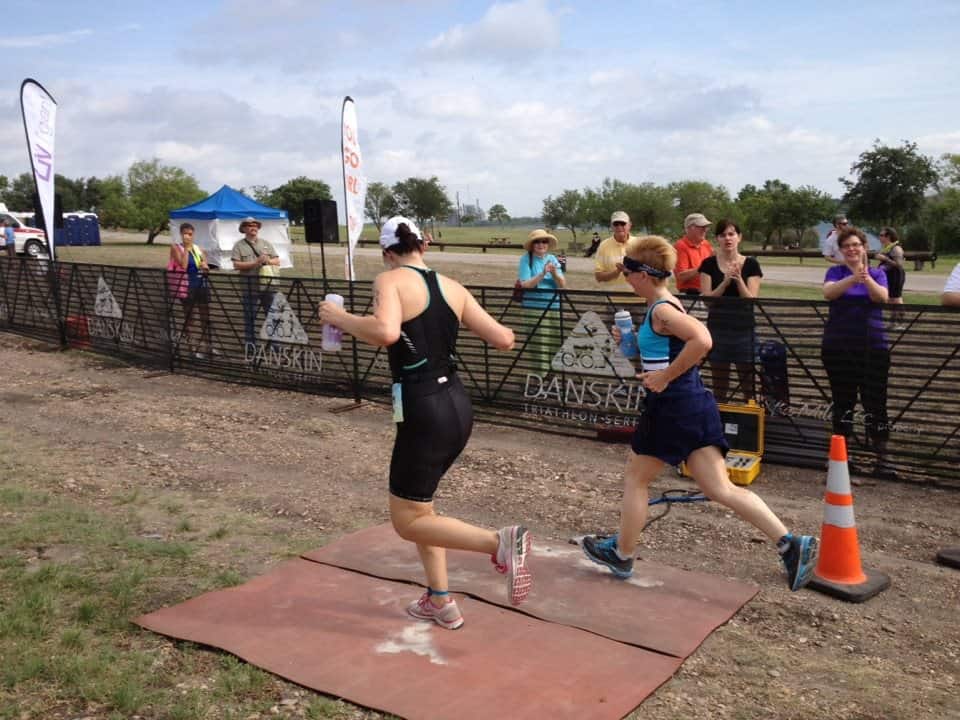
What is the best type of exercise for type 1 diabetes?
Exercise plays a critical role in blood sugar management for people with type 1 diabetes. In this article, we’ll look at the impact of exercise on blood sugar management and the best types of exercise for type 1 diabetes.
***This article is not intended to provide medical advice, diagnosis, opinion, treatment or services. This article and the links contained in it provide general information for educational purposes only. The information provided in this article is not a substitute for medical care. It should not be used in place of the advice of your physician or registered dietitian.***
Type 1 diabetes and exercise
Most people with type 1 diabetes will benefit from regular exercise, and regular activity should be recommended. Both aerobic exercise and strength training are recommended.
Each person with type 1 diabetes will respond differently to exercise and to different types of exercise. Adjustments to carbohydrate intake and insulin doses will need to be made to accommodate exercise, and continuous glucose monitoring can be used to detect potential low blood sugars.
As someone living with type 1 diabetes myself, my favorite form of exercise is heavy strength training. But, I’ve also gone through periods of my life where I really enjoyed and saw blood sugar benefits from long-distance running, swimming, and aerobics. There are many different forms of exercise that can be helpful and effective for people with type 1 diabetes.
Can type 1 diabetes be reversed with diet and exercise?
No, type 1 diabetes cannot be reversed or cured with diet and exercise. But diet and exercise are used as part of an overall management strategy to optimize health and blood sugar management.
When is the best time to exercise with type 1 diabetes?
You should exercise at a time of day that works for your schedule and lifestyle. Try to shoot for a time of day when you have the most energy and will be able to put proper effort into your exercise. Do not exercise on an empty stomach. It’s important to fuel yourself properly both before and after physical activity.
- That being said, many people report a great blood sugar benefit from exercise if they exercise in the morning.
- Insulin sensitivity increases during exercise and for a period of time afterward. It can be helpful to take advantage of this increased insulin sensitivity while you’re awake and consuming food throughout the day.
- If you are exercising in the evenings, you may not notice this benefit as much as some of this increased insulin sensitivity time would be while you are sleeping.
- Additionally, people with type 1 diabetes should not exercise if their blood sugar is low or running excessively high. Beginning exercise during either of those situations can lead to additional blood sugar issues and cause more harm than good.
Exercise guidelines for type 1 diabetes
People with type 1 diabetes should strive for 30-60 minutes of physical activity each day. This should be a combination of aerobic and weight-bearing exercises. Make sure to follow these safety guidelines when exercising with type 1 diabetes:
Keeping track of your blood sugar with type 1 diabetes and exercise
- Keep your low blood sugar treatment with you at all times. Rapid-acting treatments such as honey, glucose tabs, fruit snacks, etc., are best.
- Always have a way to test your blood sugar with you, even if you wear a continuous glucose monitor.
- If exercise lasts more than an hour, test your blood sugar at regular intervals during exercise.
- Test your blood sugar regularly for a few hours after finishing exercising to ensure you do not drop too low.
Insulin dosing with exercise
- If taking insulin before exercise, do not inject the insulin in an area of the body where you will be using your muscles the most.
General guidelines for type 1 diabetes and exercise
- Certain diabetes complications, like retinopathy or neuropathy, may limit the activities you can do safely. Talk to your doctor about what forms of exercise are best.
- Do not exercise if you feel ill or sick.
- Always wear a medical ID.
When NOT to exercise if you have type 1 diabetes
- If your blood sugar is less than 100mg/dL. Eat 15-30g of carbohydrate to raise your blood sugar above 100mg/dL, and wait 15 minutes before beginning exercise.
- If your blood sugar is greater than 250mg/dL, check for ketones, drink adequate fluids, and take medications as needed and as prescribed by your doctor to lower your blood sugar. Do not exercise until your blood sugar is under 250mg/dL.
- Do not exercise if you have ketones. Follow the treatment guidelines given to you by your doctor, and do not exercise.

What types of exercise are best for type 1 diabetes?
What is the best type of exercise for type 1 diabetes? There’s no one best exercise for people with type 1 diabetes, but there are some that may be more helpful than others. Many different forms of exercise can be effective for building muscle mass, increasing endurance and aerobic fitness, and improving blood sugar levels. Here are a few of my favorites as someone who’s been living with type 1 diabetes for over 30 years.
1. Walking
Walking is a low-impact activity that helps lower blood glucose levels and improves insulin sensitivity for people with type 1 diabetes. It’s easy to incorporate into daily routines and supports heart health without putting too much stress on the joints.
2. Jogging or running
Jogging and running at a moderate pace can boost cardiovascular fitness and aerobic health, and like walking, can increase insulin sensitivity. Running or jogging can also help lower A1C levels and improve endurance over time.
Note: These benefits apply to light to moderate levels of jogging or running. Sprinting may have the opposite effect in the short term. High-intensity activities, like sprinting, cause an adrenaline response by the body, which can cause blood sugar levels to go up in the short term. The long-term benefit of increased insulin sensitivity may still be seen, but it’s something to consider when thinking about exercise for type 1 diabetes.
3. Bike riding
Riding your bike (both stationary and road/mountain bikes) is a great aerobic exercise that strengthens the legs and improves heart health while helping to lower blood sugar. It’s also low-impact, making it joint-friendly and ideal for longer durations.
Spin classes are still one of my personal favorites for aerobic exercise!
4. Dancing
Dancing combines aerobic movement with fun and entertainment, which can lower stress hormones and make managing blood sugar levels easier. It also improves coordination, balance, and mood.
5. Swimming
Swimming provides a full-body workout that improves cardiovascular health and increases muscle mass without stressing the joints. It may be an ideal choice for people with diabetic neuropathy and someone looking for a low-impact exercise for type 1 diabetes.
6. Team sports
Playing team sports adds a social and motivational element to exercise for type 1 diabetes while providing intense bursts of aerobic activity. It can support mental well-being through teamwork and fun competition. It can be a great way to meet other people living with type 1 diabetes.
7. Lifting weights/strength training
Strength training builds muscle, which helps the body use glucose more efficiently and improves insulin sensitivity. It also supports bone health. Personally, this is one of my favorite ways to exercise as someone living with type 1 diabetes.
8. Yoga
Yoga enhances flexibility, balance, and relaxation while reducing stress, which can positively impact blood sugar levels. It also encourages mindfulness and body awareness, which may help some people better manage their blood sugar levels.
Make sure to check with your doctor or healthcare team before starting an exercise regimen for type 1 diabetes, though. They will be able to best advise you on what is safe for your unique situation. Any existing diabetes complications or injuries will impact what is safe for you to do.

Exercise for type 1 diabetes: Key takeaways
- Exercise impacts blood sugar levels and can lower blood glucose levels by increasing insulin sensitivity and helping muscles absorb glucose. However, it can also cause blood sugar to drop too low (hypoglycemia) or, in some cases, rise (hyperglycemia).
- Monitoring your blood sugar is crucial. People with Type 1 diabetes should monitor blood sugar levels before, during, and after exercise to prevent extreme highs or lows. Continuous glucose monitors (CGMs) can help track fluctuations.
- Different types of exercises will have different benefits and effects. Aerobic exercise (e.g., running, cycling) tends to lower blood sugar, while anaerobic or high-intensity workouts (e.g., weightlifting, sprinting) can sometimes cause temporary blood sugar spikes.
- Consistency Helps with Blood Sugar Stability – Regular exercise can improve overall blood sugar control, reduce insulin resistance, and support long-term diabetes management. Developing a consistent routine makes it easier to predict how your body will respond.
For more resources on diabetes and exercise, check out these articles:
- Does Exercise Lower Blood Sugar? Understanding the Immediate and Long-Term Effects
- Type 2 Diabetes and Exercise
- Exercise and Diabetes Guidelines





